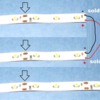A picture is worth a thousand words so....

18-21V AC track voltage enters on the left. 12V DC to the LED strip exits on the right. If using DCS you should install a 22uH inductor (a.k.a. "DCS choke") in one of the AC inputs. Without this inductor, the capacitor in the AC-to-DC conversion process is known to drag down the DCS signal.
Then, to perform the AC-to-DC conversion you can use either an AC-in, DC-out converter module shown at top, or a DC-in, DC-out module shown at bottom. The DC-in module requires an external bridge rectifier and additional capacitor. That is, the DC-in module indeed has a small onboard capacitor but for the power levels you'll be working at you should add additional external capacitance. Note that the AC-in module has such a larger capacitor. The components are not expensive but when you only need 1 or 2 but have to buy a bag of 10 or 20 it can get tedious.

Both versions I show come with screw-terminals for input and output. I happen to find this convenient but if willing to solder wires to the module you can probably save on cost. I also show a DC-in version that has an integral DC voltmeter; I am not aware of an AC-in, DC-out converter with built-in voltmeter. This can be handy if working under the layout in that you don't have to awkwardly mess with a voltmeter while adjusting the tiny screw which adjusts the output DC voltage (brightness of strip). Or as discussed in previous post, you can get the basic (no voltmeter, no screw-terminal) version for less than $2 each when you buy a bag of 10.

As has been discussed, the LED strips in various lengths though you'll probably be buying a 5-meter rolls. Unless you have a long-skinny 5m/16ft yard, I figure you'll be cutting the strip into multiple sections. There are "cut-lines" every 3rd LED. Then solder a pair of wires from + to + and - to -. For an under-table yard I figure the LED strips are relatively close to the trains. In other words you are not trying the illuminate a kitchen or living room. Hence, I'm suggesting you won't be driving the LED strips at full-power (12V) but rather at maybe 10 or 11V using the adjustment screw on the converter.
If just getting started with these LED strips it is indeed difficult to guess-timate how many Lumens or Watts or whatever you need.
I have no idea how large your under-table yard is but to ballpark some numbers, I'll say 20 Watts of power which you'll be "stealing" from the 180 Watts of available power on a Z-4000 track output. Hobby-grade LEDs produce maybe 50-75 Lumens per Watt. And there are power losses here and there. Anyway, I'm thinking ~1000 Lumens - about the light you'd get from a pair of incandescent 40 Watt bulbs. Your mileage may vary! 










